
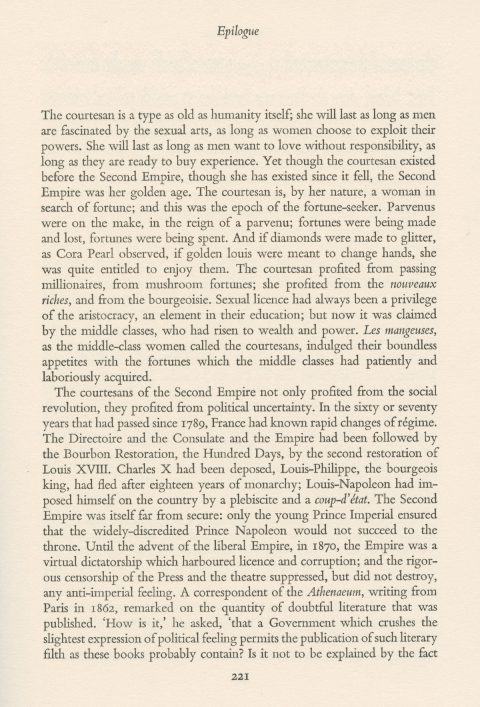
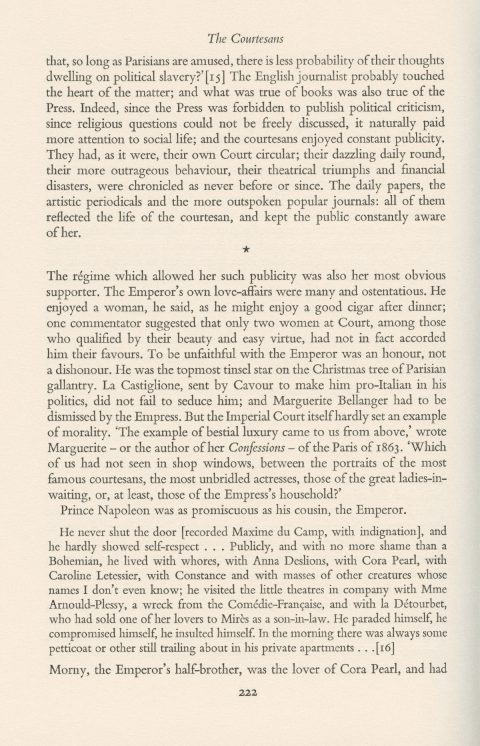
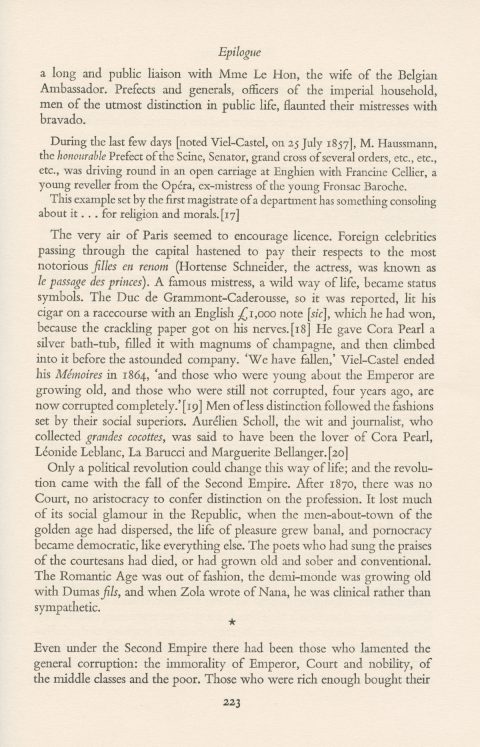
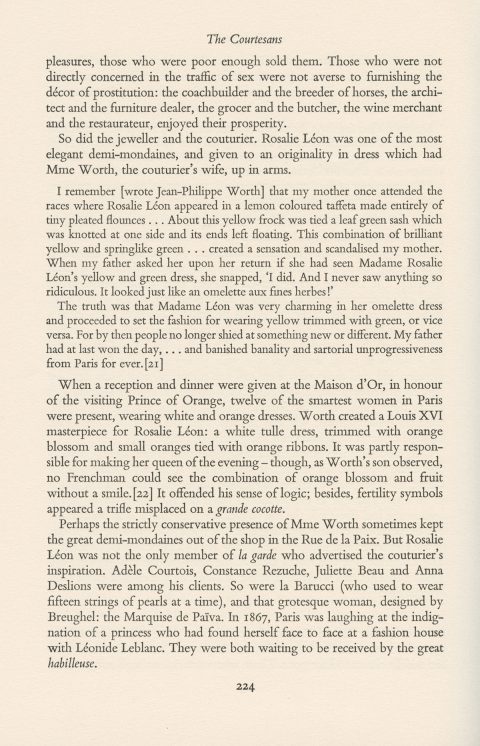
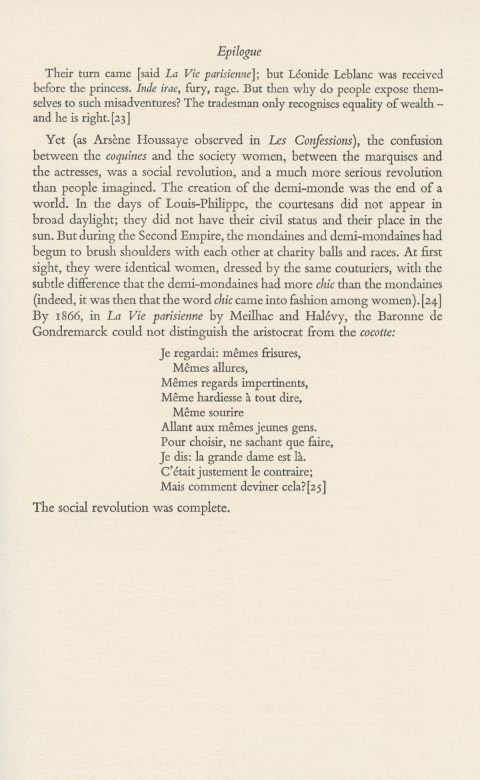
Outro from the magnificent The Courtesans — The Demi http://nygoodhealth.com Monde in 19th Century Paris by Joanna Richardson






Outro from the magnificent The Courtesans — The Demi http://nygoodhealth.com Monde in 19th Century Paris by Joanna Richardson
George & the Dragon
John BurnsideThis killing will never stop.
It’s not enough
to slay the beast, he has to make it clear
how calm his loathing is, how utterly devoid
of fellow feeling;and though she is present,
the woman is incidental;
whatever he hoped in the past, he’s not here, now,
for the wet of her mouth on his skin, or his curdled handstangling in the spilt folds
of her gown.
It isn’t love he lacks. It’s narrative.
The gown is red, which symbolisesotherworldly grace, or else
protection from the witchery of blood
– it’s hard to say
what ritual this is. All we can knowfor sure is that too much is being
sacrificed, the dragon with its throat
transpierced, a sign
left over from the damp, pre-Christian world,led from the cave on its chain (the woman holds it
lightly in her hand) to be destroyed
for no good reason, given that it’s tame
and captive now.Perhaps it’s just too green
or too expressive, set against this knight
whose mind is elsewhere, blank as ordinance
and formal, like the host, or likethis seeming bride-to-be, whose only love
is senseless agape.
No guessing what lightens their days; no guessing
how quietly each soul upholds its greydominion, at the near edge of a marsh
that runs into the dark
forever, gulls
and egrets flickering acrossits waterlands, a salt wind in the grass
so like a voice, the body longs
to follow;
but they never leave this spot
where flesh is conquered, time and time again,the lance fixed in the dragon’s
larynx, old blood
cooling in the sand, like candlewax,
the cave a myth, the storm, mere ornamentthe new god in the throne room
of high heaven,
observing our trespasses, judging us,
keeping us pure..
When I look at these absolutely breathtaking handmade made-to-order objects by Swedish fabircator Love Hulten, I covet.
In fact I covet three ways. At first I covet crassly, wishing I could afford these hand turned masterpieces. Then a little more thoughtfully, I covet the skills & craft to build these kinds of things myself. Then, finally, I covet philosophically, wishing that this was a genuine commercial aesthetic — that as we chase the geewhiz we’d take the texture and soul of what worked before and roll it in as we roll foward. We’ve left so many beautiful things behind.
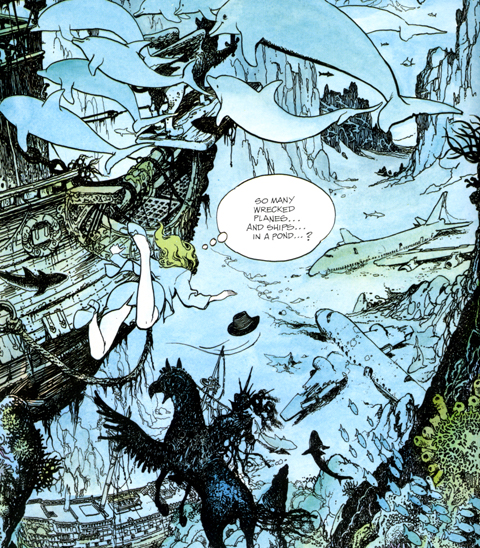
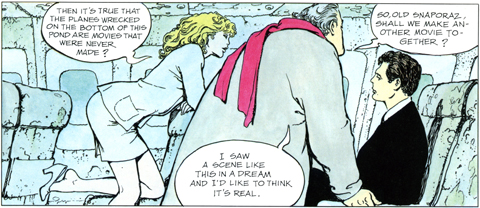
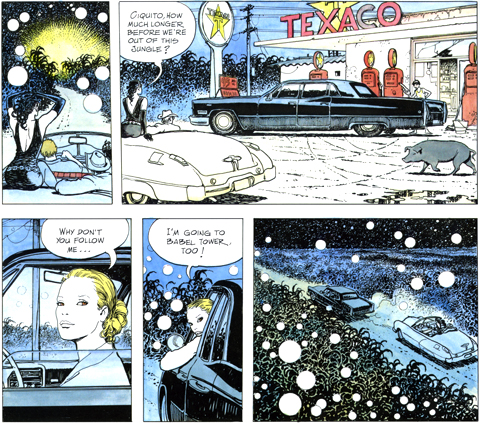
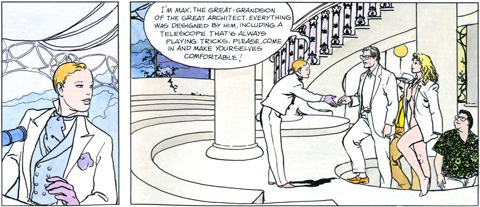
[RERUN: Originally Aired Sept. 2009 / An old favorite lost in the great SQL database corruption of 2012. I never tire of thinking about the electric confection that is Fellini & Manara’s Trip to Tulum, so here it be. Admittedly dated by my still fresh allergic rejection of the very idea of Zac Snyder’s appalling adaptation of Watchmen}
Comics, and the ghostly fascination of those paper people, paralyzed in time, marionettes without strings, unmoving, cannot be transposed to film, whose allure is motion, rhythm, dynamic. It is a radically different means of addressing the eye, a separate mode of expression. The world of comics may, in its generosity, lend scripts, characters and stories to the movies, but not its inexpressible secret power that resides in that fixity, that immobility of a butterfly on a pin. –Federico Fellini
The graphic novel Trip to Tulum has its roots in an aborted film of Fellini’s called the Journey of G Mastorna. Fellini’s entry in the “whoa… he was dead the whole time” mini genre, the movie was plagued by strange mishaps throughout its production. Already haunted by nightmares, Fellini threw in the towel after a huge Gothic church set collapsed minutes after it had been erected. The script and its attendant themes and vignettes sunk back into Fellini’s imagination. Over time bits and pieces floated to the surface in other films.
Fellini’s affection for comics and graphic storing telling is well known. In the mid 80’s, he allowed an Italian newspaper to serialise a version of the story, now called Trip to Tulum, with accompanying illustrations by Milo Manara. Manara, mostly known for his tony, Euro sci-fi erotica, is an illustrator and artist of the highest caliber. When Manara wanted to expand the story into a graphic novel, Fellini agreed, and took to the collaboration with gusto.
The result is simply one of the lost classics of the form. It begins with a stunning Anita Ekberg ringer finding Fellini asleep on the edge of pond in a a lush grove swept through by gusts of wind. Fellini’s hat flies off and as she reaches to grab it she falls in. Swimming after the sinking hat she descends to a vast, surreal field of sunken planes and ships. It emerges that they are all physical manifestations of Fellini’s films and unrealized notions. On one plane she finds a nattily dressed, kelp encircled Marcello Mastroianni, and…. oh never mind, from there the story just unfurls from one scene to the next like wax balls in a lava lamp… it’s a frisky fantasy adventure, a hallucinatory dream, a self referential commentary, an allegory of film-making, and finally a meditation on the creative act itself. Out of print now, copies can be found here.
(Incidentally, the Fellini quote is one of the definitive statements on the relationship between movies and comics. The notion of characters on “loan” lies at the heart of Chris Nolan’s respectful yet inspired cinematic interpretations of Batman. Its warning against literalism is precisely what an earnest vulgarian like Zach Snyder does not understand – which is why there is nothing whatsoever to be gained, and everything to be lost, in seeing Watchmen)
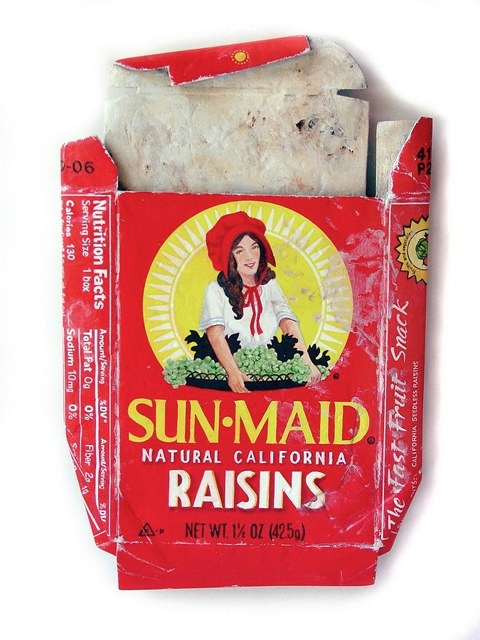
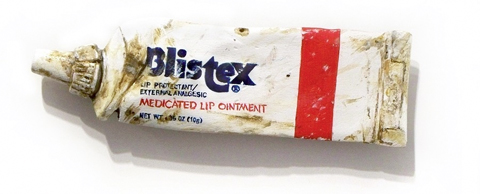


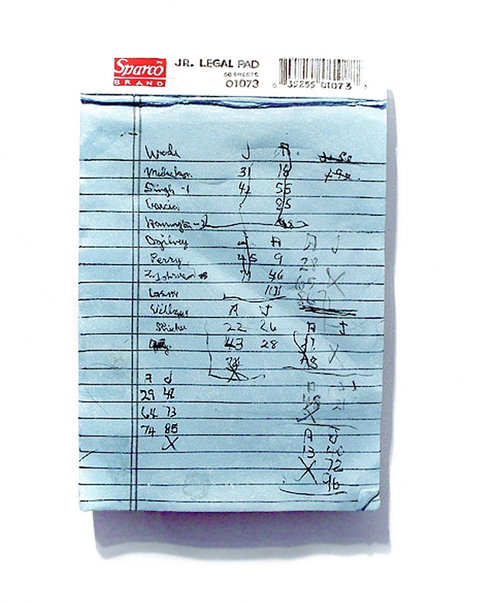
[RERUN] A few months ago couple of years ago I was in Vegas for that Matador @ 21 shindig… Funny thing about Vegas for the occasional Logan’s Run/Disneyland casino-plex rooted visitor – when you head out into the actual, dust-whipped city you get that slight shifted-reality feeling, like when you travel abroad. That slightly off-kilter disjointedness is one of my favorite things about wandering around Vegas. My pal & I were returning from a few hands of profitable mid-day blackjack in grubby/glammy old Vegas when we spotted an old storefront window filled with poppy pop-art looking art. We docked the Prius and headed inside.
The Trifecta Gallery is a marvel, a sharply curated mix of figurative art. The prevailing sensibility is a mix of deft technique and topical whimsy. As I was scanning a particularly dense clump of work I paused on a painting of an over-sized, flattened Sun Maid raisin box. I’m an easy mark for this kind of thing, and have always found the Sun Maid herself pretty fetching. I peered in close, to take in the detail of the piece when I noticed that the shadow it cast had dimension to it. Damn buy vicodin canada thing was a sculpture. The owner, the open, warm, enthusiastic Marty Walsh, noticed me noticing the work and came over. We got to talking and after we established our mutual fondness and amazement for the piece she took me back to look at more. Two flat files drawers full – Blistex Tubes, popcorn boxes, notepads, lip balm, and a host of to-go cups. Each one slightly larger than life, and carved into soft block of wood.
They are the work of Tom Pfannerstill, from Louisville, Kentucky. Pfannerstill retrieves “trash” from the street, or as he puts it, “markers of a time… a tiny part of the fossil record, a small archaeological artifact.” He then crafts meticulous recreations which “touch on issues of commercialism and consumerism, but are mostly intended to be subtle reminders of the temporality of all things.” That they do, quite powerfully, and they impress with their sheer bravura technique as well. The pieces are modestly priced, and available through Trifecta. Just wonderful. And if you’re in Vegas, stop in. Walsh is a delightful host, and the place is part of a ramshackle series of interconnected galleries all work poking about in…
Here’s a quick one — a sketch portrait of Ursula Andress as Vesper Lynd in the technicolor carnival that was the original Casino Royale. The one where Peter Sellars seduces her behind the fish tank. When I cut the painting I had accidentally done it in almost the exact aspect ratio of TODD-AO, hence the title. Best to click, it’s a long one, so it shrinks tiny. Cheers
Some recent moments of pop happenstance wandering around Philadelphia — Ellsworth & Broad, and shop buy vicodin 10mg windows on Bainbridge and 4th street respectively. Topmost iPhone, the others digital SLR — Enjoy.
Ocean, 1975 Vija Celmins / drypoint on paper
What we call seeing a thing clearly, is only seeing enough of it to make out what it is; this point of intelligibility varying in distance for different magnitudes and kinds of things, while the appointed quality of mystery remains nearly the same for all. Thus: throwing an open book and an embroidered handkerchief on a lawn, at a distance of a half a mile, we cannot tell which is which: that is the point of mystery for the whole of those things. They are merely white spots of indistinct shape. We approach them, and perceive that one is a book, the other a handkerchief but cannot read the one or trace the embroidery of the other. The mystery has ceased to be in the whole things, and has gone into their details. We go nearer; and can now read the text and trace the embroidery, but cannot see the fibers of the paper or the tread. The mystery has gone into a fourth place, where it must stay until we take a microscope, which will send it into a fifty, sixth, hundredth or thousandth place. —John Ruskin on the picturesque sublime
Juxtaposition by Dave Hickey / 25 Women: ESSAYS ON THEIR ART, 2016 / Univ. of Chicago Press
So, Bowies’ Blackstar arrived, finally — ordered while Bowie was earthbound, listened to when he wasn’t. Let me see if I can get this exactly right — it’s the first & last classic Bowie record since Let’s Dance.
Bowie played rock like Duchamp-ian chess. Each classic Bowie album occupied & held a square on the board. The records are “about” the move, so they work as self contained experiences — they point inward, ultimately.
This is why the whole “best album since Scary Monsters” critical framing misunderstands Bowie. Although he released some great salvos since Let’s Dance, they didn’t represent moves to a new square. Sometimes, like Earthling, he deftly rode a cultural or aesthetic wave, othertimes like Heathen or even The Next Day they were grand & vital reprises of old glories.
Blackstar is, before it is anything, a bracingly new statement. The avant-jazz hybrid he’s synthesized here is — once again, like all classic Bowie — an occupying move. The album refers, thrillingly, only to itself. There’s a new sound & vision here — skronky, sinewy, dubby… What a triumph!
Honestly, I was wary of listening, & crabby that I hadn’t the opportunity to hear it at at least once as the work of a living artist. I shouldn’t have fretted. Rather than a melancholy encomium, a stately funeral parade, it was the best & most unexpected gift of all — The last classic Bowie album: Space Oddity, Man Who Sold the World, Hunky Dory, Ziggy, Aladdin Sane, Diamond Dogs, Young Americans, Station to Station, Low, Heroes, Scary Monsters, Let’s Dance, Blackstar.
There’s a reason when the news hit that so many of us instinctively reach out and gather our memories of first hearing ChangesOneBowie / Because that wasn’t a record, it was a door. A magic door. Here’s how it was magic. Because if you knocked on it, it opened easily, and you could go in and just boogie. But. But. If you pushed on it just right, if you were bent, just so, you tumbled through — and you never stopped falling. And as you fell, year after year, your freak flag just kept unfurling. And as you fell & flew you wondered — when do I get to the bottom? And there is no bottom. It’s just Bowie all the way down. Today every freak flag flies at half mast. Goodbye David Bowie.
My last flareup of Star Wars fever — These illustrations were featured on the playing cards included with Escape from Death Star board game. Playing it again out of sheer nostalgia confirmed my vague memory of the game itself as pretty janky. I was struck, however, by these quick, scratchy, pen & ink sketches of iconic scenes from the movie. More than anything they reminded me of Jim Holdaway’s classic Modesty Blaise newspaper strip that ran throughout the 1960s. In any case, just hanging this small bit of ephemera here on the Internet in case anybody needs it.
Also while we’re the closing subject I’ll leave you with the smartest pop cultural assessment I’ve read of the new flick, the essence of the original, the folly of the prequels (of which I’m finally mostly persuaded, although I’m still with Kevin Smith on Sith) — Our Star Wars Holiday Special by Aaron Bady in The New Iquiry:
[The prequels] were marred by horrific writing and joyless characters, of course, but those superficial failings pale in comparison (or resulted buy vicodin los angeles from) the more fundamental underlying problem: they tried so hard to explain that they killed the joy of the thing itself… How did Anakin Skywalker become Darth Vader? How did the republic fall? Where did the emperor come from? How did Luke and Leia end up separated, who is Obi Wan Kenobi, and where are all the mothers in this universe? These are not plot holes; these are the dark matter that holds the galaxy together… Instead of placing their faith in the force—the way an open-mouthed child lets the storyteller carry them off—the prequels tried to explain what the force really was and worked so hard at it that they made the entire thing tedious and boring. They turned their targeting computer back on.
It also has perceptive & compact assessments of Star Trek vs Star Wars and why JJ Abrams’ approach arguably disfigured the former while revitalizing the latter (again persuasive personally, but my imaginative stake in Trek is much looser so I think the reboots are mostly a gas) With this, then — nerd. Out.